IDEX Online Research: Challenges 2008- Online Jewelers Poised to Change the Industry
February 21, 08
It’s not the online shopping experience that worries us. For many reasons, we believe that shoppers worldwide will continue to do most of their shopping in bricks-and-mortar stores.
What worries us is the financial model that online jewelry merchants have developed.
Stores Will Continue to Dominate
Store-based retailing has a long and rich history. Two thousand years ago, crowds of people shopped in the agora – the marketplace – at the foot of the Acropolis in ancient Athens. Today, more than 95 percent of all retail transactions still take place in a store, often in a mall reminiscent of the ancient agora.
Non-store retailing is not new. Throughout history, there has always been some small portion of retailing which was conducted beyond the bounds of a merchant’s store. In America, Ben Franklin published a catalog in 1744 that offered scientific and academic books, with the guarantee: “Those persons who live remote, by sending their orders and money to said B. Franklin may depend on the same justice as if present.” In 1872, Aaron Montgomery Ward shipped his catalog to farmers throughout the Midwest. In 1886, Richard W. Sears and his partner Alva Roebuck created not only a catalog, but American folk history as well. In 1912, L.L. Bean initiated his catalog in which he offered far-flung shoppers a hunting boot with a lifetime guarantee.
At the peak in the early 1980s, catalogers had captured less than 3 percent of all retail dollars spent in America.
Non-store retailing seems like a logical choice for shoppers: it’s convenient, quick, easy, painless, and all of those things that Americans seem to crave. For merchants, it also offers benefits: no store expense, flexible hours, few employees and lower costs.
Online commerce is the latest “non-store” retailing concept. No one knows how much market share online retailers will eventually take. We believe that the hybrid model is the most likely winner – merchants who operate both bricks-and-mortar stores and online stores. That’s the best of both worlds.
So why won’t stores go away? It is important to understand the shopping experience. There are five key reasons that people shop:
- To buy something – Stores, catalogs, and online merchants all offer goods for sale. Similarly, there are other retail distribution channels such as “home party plans” in which the merchant, often someone’s neighbor, gathers friends and sells goods in the privacy of the home, usually with a social atmosphere (that’s why they are called “home party plans”). Consumers can also buy from vendors, mostly unlicensed vagrants, along the streets of any major city around the world. Shoppers – disparagingly called “couch potatoes” – can turn on their television and buy from any number of merchants selling goods on shopping channels such as QVC, Jewelry Television and others.
- For the social experience – Many shoppers go to the mall “to see and been seen.” They go shopping to see other people, and to be seen by other people. Malls are a great place to people-watch. Shoppers meet their friends at the mall for social activities such as dinner in a mall restaurant. It is difficult to create a similar social experience in a non-store environment, though some television shopping merchants take on-air phone calls from shoppers in an effort to create a friendly social setting.
- For the recreational experience – For many people, shopping is fun. It is something to do on a rainy dreary afternoon. It is a way of killing time, letting off steam, shedding the stress of the day. Americans claim to have invented recreational shopping but for centuries people – especially noblemen and noblewomen – have shopped for pleasure. It is difficult to create a similar recreational experience in a non-store shopping environment, though indiscriminately surfing the internet comes close. Unfortunately, most store-based merchants don’t understand the concept either, thus, they offer shoppers little chance for recreation. The Apple store has a section for kids to use computers and other electronic gadgets; sporting goods retailers have climbing walls. Perhaps jewelers ought to let shoppers pan for gold.
- For a tactile experience – Most consumers are tire-kickers: they need to touch and feel the merchandise. Is the cloth soft? Is the fruit firm? Is the gold jewelry heavy? In addition, there is a psychological reason to have people pick up their merchandise: once it is in their hands, the decision to buy is made instantly. Even before shoppers arrive at the cash register in a store, they speak of their selections as “their food, or their dress, or their hammer.” Once a consumer has touched the goods, a huge barrier has been removed. Non-store merchants simply cannot offer a tactile experience for shoppers.
- For instant gratification – When we want something, we usually want it now. American Baby Boomers popularized the notion of instant gratification, but it has always existed. In an effort to offer something close to instant gratification, many online merchants offer overnight shipping. However, there is nothing like going into a store and owning a product instantly. Non-store merchants can’t match that store experience.
Online Jewelers Have Above Average Market Share
In the U.S. market online jewelers have captured about 3.9 percent of total jewelry sales, based on 2006 retail sales figures. In contrast, online merchants of all other retail categories have captured just 2.8 percent of all retail sales.
The graph below illustrates the disparity between market share of online jewelry sales and sales in other retail categories.
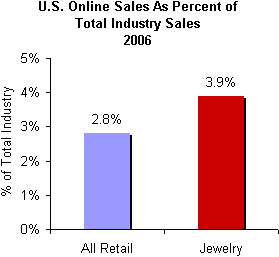
Source: US Department of Commerce
Why have online jewelers been able to capture above-average market share? After all, jewelry is difficult enough to sell in a store environment where each sale must be handled by a sales associate, and there is no such thing as “self-service.”
The primary reason online jewelers have captured significant market share is because of the product mix of online jewelry sales. In a typical specialty jeweler’s store, about 50 percent of the sales are diamonds and diamond jewelry which carry an average ticket (at the mass market level) which is double the average ticket of the entire store.
In other words, diamond jewelry is among the most expensive product category in a jewelry store. Online merchants, by contrast, generate nearly 80 percent of their sales from diamond jewelry, with its inherently higher average ticket. Further, the average ticket for online jewelers who specialize in diamond engagement jewelry is far higher than a store-based merchant.
Among bricks-and-mortar stores in the U.S. market, the average ticket for a diamond engagement ring is about $3,200, while Blue Nile’s average ticket for a diamond engagement ring is about $5,700. Further, Blue Nile’s average jewelry ticket is over $1,500 while the typical mass market jeweler generates an average ticket of about $350 and a better-end AGS type jeweler generates an average ticket of nearly $1,100. Thus, online jewelers are “skimming the cream” by taking the big ticket sales that generate significant gross profit dollars, even though the online jeweler’s margin is far below the industry average for a store-based jeweler.
The two graphs below illustrate the difference in the product mix between online jewelers and store-based jewelers. The first graph shows that online jewelers’ sales mix is about 80 percent diamonds and diamond jewelry. The balance is comprised of all other categories.
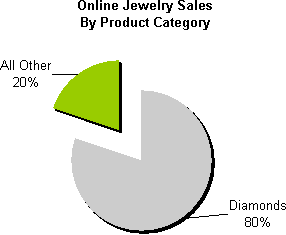
Source: JIRI estimates
The second graph, below, illustrates that the typical specialty jeweler generates about 48 percent of sales from diamonds and diamond jewelry. A higher-end store relies even less on diamond jewelry – the typical AGS-type store generates less than 40 percent of sales from diamonds and diamond jewelry.
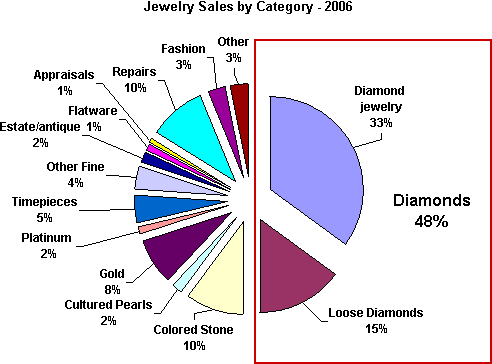
Source: JA
Furthermore, it is important to note that most online jewelry sales are commodity goods – basic pendants, rings and ear studs. It is easy to compare prices on these basic goods, and the certificates which accompany them summarize the specifications of the diamond.
Most online jewelers have been unable to penetrate the market for fashion jewelry. Their business model does not work well with “one-off” products, and it is difficult for the customer and the jeweler to interact on custom jewelry designs. Blue Nile is exploring jewelry customization, but the heart of the company’s product mix remains commodity diamond jewelry.
Online Financial Model
There is no question about it: online jewelers have developed a streamlined financial model that allows them to sell for less, but generate pretax profit margins that are nearly double the level of a typical store-based specialty jeweler.
The most glaring difference in the financial model between online jewelers and bricks-and-mortar merchants is their gross margin, defined as revenues less cost of goods. The typical store-based jeweler generates a gross margin near 50 percent. In dramatic contrast, the typical online jewelry merchant such as Blue Nile generates a gross margin of just over 20 percent. Here’s what this means: online jewelers sell for less. There is no escaping this conclusion. Even without the financials, which can be found in legal filings with the Securities and Exchange Commission, consumers can price-compare like-for-like goods, especially since the industry now provides certificates with most diamonds.
The graph below illustrates the disparity between online merchants’ gross margin and bricks-and-mortar retailers’ gross margin.
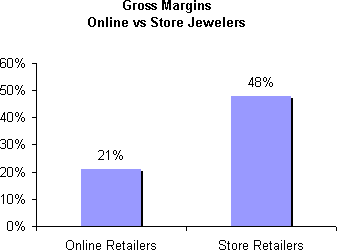
Source: Company reports
While shoppers are less interested in the comparison of other financial metrics of online jewelers versus store-based jewelers, both commercial bankers and investment bankers are very interested in these financial comparisons.
From the viewpoint of a banker, online jewelers have an extremely attractive financial model. Not only are pretax margins nearly double the level of store-based jewelers, but online jewelers’ inventory turn multiples faster than store-based jewelers. Online jewelers leverage their suppliers much more, and need far less capital to run their business. Thus, interest costs are minimal for online merchants.
While IDEX Online Research believes that it will not be possible for store-based jewelers to emulate the financial model of online merchants, we believe that they must learn how to lean on their suppliers for merchandise and credit. They must learn how to operate more efficiently and generate better margins.
The table below summarizes some key financial metrics of online versus store-base jewelers.
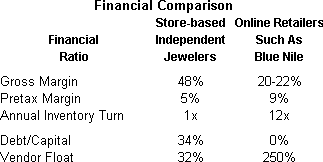 Source: Company reports |
The table below compares some key merchandising metrics of online jewelers versus their store-based counterparts.
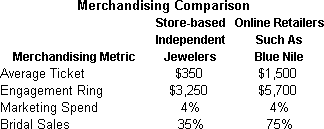 Source: Company reports |
The table below compares some key operating efficiency and productivity measures of online jewelers versus store-based merchants.

Source: Company reports
Online Jewelry Outlook: Slowing Growth
The internet is only a channel of distribution. It does not create new consumers (the birth rate isn’t up since the internet has become mainstream), and it does not create any new money (the printing presses at the U.S. mint aren’t spinning any faster these days.) So, there are some basic constraints to growth of non-store online sales.
Furthermore, retailing is basically a sum-zero game. As an economist, we understand the concept of the “velocity of money.” But as our grandmother said, “You can only spend that dollar once.”
The bottom line is this: online sales growth will slow. Our forecast calls for slowing growth of online jewelry sales, for some very practical reasons:
- Mathematics – Percentage gains diminish as the numbers get larger. The graph below summarizes our forecast for percentage gains in online jewelry sales.
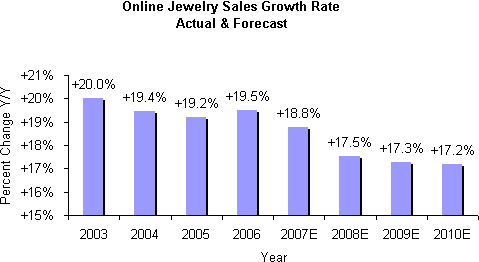 Source: Department of Commerce & IDEX Online Research |
- Maturity – Like every other channel of distribution, as the online distribution channel begins to reach maturity (defined as fewer and fewer new customers opting to purchase online), growth will slow. The “early adopters” (that’s a term demographers use to distinguish a subset of consumers who want to be the fist to use anything new, like new technology or the iPhone) have already logged on and are shopping at their favorite online merchants. Thus, the low-hanging fruit has been plucked. The next group of consumers won’t sign up for online commerce at the same rate as the early adopters.
- Other categories – Assuming that some other jewelry categories, such as pearls, precious metals jewelry, estate jewelry, etc., will begin to sell online (there is some question about the validity of this assumption), the lower average ticket of most of those jewelry categories will slow the pace of online jewelry sales growth.
- Store-based retailers fighting back – Merchants have livened up their stores to be more alluring. Traditional stores are creating a more interactive shopping experience.
- Online shopping is “work” – Online shopping, because it involves a computer, feels like work; online shopping is more of a “chore than an escape.
- Online sellers’ price advantage diminished – Higher shipping fees and sales taxes have begun to level the retail playing field between online merchants and store-based retailers.
There is a theoretical maximum for online sales versus in-store retail sales. Some online trade magazines tend to suggest that 10 percent of all U.S. retail sales is the theoretical maximum level for online retailing. Others scoff at this number, suggesting that it is way too low. Either way, we are in virgin territory and no one really knows the answer. Assuming that online jewelry sales top out at 10 percent of industry sales, this means that 90 percent of all jewelry industry sales will still be made via traditional bricks-and-mortar stores. This fact seems to be lost on too many merchants. Online commerce isn’t going to put store-based jewelers out of business, other than the weakest merchants who are already on Death Road.
The graph below illustrates the range of our projections for online jewelry sales in the U.S. market through the end of the current decade.
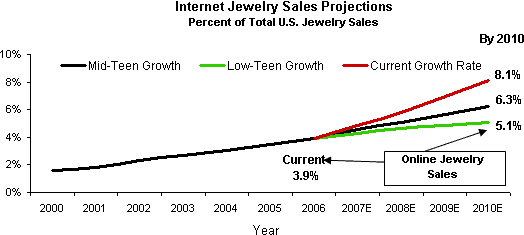
Source: Department of Commerce & IDEX Online Research
What Can Store-Based Jewelers Do About Online Retailing?
Last year, we developed a presentation titled, “Online Commerce: Be There or Be Square.” This presentation is available at no charge from IDEX Online. Here are some of the salient points from the presentation.
- If you, as a store-based jeweler, don’t have an online presence, you are very late to the party. You will have a difficult time catching up.
- Unless you have millions of dollars available for marketing, you don’t stand a change of replicating Blue Nile’s success.
- You need to have some online presence – at the very least, an electronic calling card.
- Store branding is best for your website; it reinforces a single name in the consumer’s mind.
- Your online price and your store price should be the same. More jewelers have found success with this formula versus a two-tier pricing concept.
- Creating a website is not a do-it-yourself project. Your niece Sally who is studying graphics art in college, can’t do the job.
- Despite claims to the contrary, no one has successfully rolled out internet “kiosks” in jewelry stores. There’s a cultural barrier with your current sales force.
- Don’t put your whole store online. Tease shoppers with enticing merchandise which will lure them into your bricks-and-mortar store.
- Make sure you have a unique selling proposition. A half-carat diamond pendant at any price is not a competitive differential.
- Lean on your suppliers to help you build your website.
- Make sure you sell jewelry online, in addition to diamonds. The margin is in jewelry, not diamonds.
- Study the online merchants’ financial model. It is the wave of the future.
What Will The Future Bring?
Consumers are not committed to one channel of distribution versus another; they will switch back and forth. Thus, it is no surprise that a clicks-and-bricks hybrid model seems to be emerging. Some retailers offer in-store pickup of items purchased online; this tends to raise the average ticket since shoppers often buy additional merchandise when they come to pick up their items. However, while the hybrid retailing model seems to be working in some retail categories, we haven’t seen it implemented successfully in the jewelry industry, yet.
Diamond suppliers have the greatest opportunity to exploit the power of online commerce. Why? They own the diamonds. Look for your diamond suppliers to open web stores.
The mine-to-market model is still the most profitable. Look at Aber, De Beers and Leviev, if you don’t believe it. These merchants are in the best position to leverage online commerce.
To Reiterate: Don’t Compete on Price
Remember the discounter who said he loses a little money on each sale, but he makes it up on volume? He went bankrupt. And you will too, if you try to compete with online jewelers solely on price.
***
This article is part of a series that expand on the points IDEX Online’s director of online research, Ken Gassman has raised in his analysis “State of the Jewelry Industry.”
Ken is available to speak to corporate management groups and others about the State of the Jewelry Industry. He has developed a PowerPoint presentation which can be customized to your group. For further information, please email Ken at research[at]idexonline[dot]com.